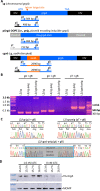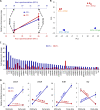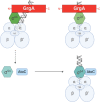Requirement of GrgA for Chlamydia infectious progeny production, optimal growth, and efficient plasmid maintenance
- PMID: 38112466
- PMCID: PMC10790707
- DOI: 10.1128/mbio.02036-23
Requirement of GrgA for Chlamydia infectious progeny production, optimal growth, and efficient plasmid maintenance
Abstract
Hallmarks of the developmental cycle of the obligate intracellular pathogenic bacterium Chlamydia are the primary differentiation of the infectious elementary body (EB) into the proliferative reticulate body (RB) and the secondary differentiation of RBs back into EBs. The mechanisms regulating these transitions remain unclear. In this report, we developed an effective novel strategy termed dependence on plasmid-mediated expression (DOPE) that allows for the knockdown of essential genes in Chlamydia. We demonstrate that GrgA, a Chlamydia-specific transcription factor, is essential for the secondary differentiation and optimal growth of RBs. We also show that GrgA, a chromosome-encoded regulatory protein, controls the maintenance of the chlamydial virulence plasmid. Transcriptomic analysis further indicates that GrgA functions as a critical regulator of all three sigma factors that recognize different promoter sets at developmental stages. The DOPE strategy outlined here should provide a valuable tool for future studies examining chlamydial growth, development, and pathogenicity.
Keywords: Chlamydia; GrgA; regulation of gene expression; transcription factors; transcriptional regulation.
Conflict of interest statement
The authors declare no conflict of interest.
Figures








Update of
-
Requirement of GrgA for Chlamydia infectious progeny production, optimal growth, and efficient plasmid maintenance.bioRxiv [Preprint]. 2023 Aug 2:2023.08.02.551707. doi: 10.1101/2023.08.02.551707. bioRxiv. 2023. Update in: mBio. 2024 Jan 16;15(1):e0203623. doi: 10.1128/mbio.02036-23. PMID: 37577610 Free PMC article. Updated. Preprint.
Similar articles
-
Requirement of GrgA for Chlamydia infectious progeny production, optimal growth, and efficient plasmid maintenance.bioRxiv [Preprint]. 2023 Aug 2:2023.08.02.551707. doi: 10.1101/2023.08.02.551707. bioRxiv. 2023. Update in: mBio. 2024 Jan 16;15(1):e0203623. doi: 10.1128/mbio.02036-23. PMID: 37577610 Free PMC article. Updated. Preprint.
-
GrgA overexpression inhibits Chlamydia trachomatis growth through sigma66- and sigma28-dependent mechanisms.Microb Pathog. 2021 Jul;156:104917. doi: 10.1016/j.micpath.2021.104917. Epub 2021 May 1. Microb Pathog. 2021. PMID: 33940135 Free PMC article.
-
Role for GrgA in Regulation of σ28-Dependent Transcription in the Obligate Intracellular Bacterial Pathogen Chlamydia trachomatis.J Bacteriol. 2018 Sep 24;200(20):e00298-18. doi: 10.1128/JB.00298-18. Print 2018 Oct 15. J Bacteriol. 2018. PMID: 30061357 Free PMC article.
-
Type III Secretion in Chlamydia.Microbiol Mol Biol Rev. 2023 Sep 26;87(3):e0003423. doi: 10.1128/mmbr.00034-23. Epub 2023 Jun 26. Microbiol Mol Biol Rev. 2023. PMID: 37358451 Free PMC article. Review.
-
Chlamydial Plasmid-Dependent Pathogenicity.Trends Microbiol. 2017 Feb;25(2):141-152. doi: 10.1016/j.tim.2016.09.006. Epub 2016 Oct 3. Trends Microbiol. 2017. PMID: 27712952 Free PMC article. Review.
Cited by
-
Pathogenicity and virulence of Chlamydia trachomatis: Insights into host interactions, immune evasion, and intracellular survival.Virulence. 2025 Dec;16(1):2503423. doi: 10.1080/21505594.2025.2503423. Epub 2025 May 15. Virulence. 2025. PMID: 40353442 Free PMC article. Review.
-
Expression activation of over 70% of Chlamydia trachomatis genes during the first hour of infection.Infect Immun. 2024 Mar 12;92(3):e0053923. doi: 10.1128/iai.00539-23. Epub 2024 Feb 1. Infect Immun. 2024. PMID: 38299827 Free PMC article.
-
Chlamydia plasmid-encoded protein Pgp2 is a replication initiator with a unique β-hairpin necessary for iteron-binding and plasmid replication.Infect Immun. 2025 Mar 11;93(3):e0060224. doi: 10.1128/iai.00602-24. Epub 2025 Feb 7. Infect Immun. 2025. PMID: 39918305 Free PMC article.
-
Chlamydia plasmid-encoded protein Pgp2 is a replication initiator with a unique β-hairpin necessary for iteron-binding and plasmid replication.bioRxiv [Preprint]. 2024 Nov 15:2024.11.14.623704. doi: 10.1101/2024.11.14.623704. bioRxiv. 2024. Update in: Infect Immun. 2025 Mar 11;93(3):e0060224. doi: 10.1128/iai.00602-24. PMID: 39569140 Free PMC article. Updated. Preprint.
-
A lineage-specific heat-induced feedback loop controls HrcA to promote chlamydial fitness under stress.bioRxiv [Preprint]. 2025 May 30:2025.05.30.657042. doi: 10.1101/2025.05.30.657042. bioRxiv. 2025. PMID: 40501649 Free PMC article. Preprint.
References
MeSH terms
Substances
Grants and funding
LinkOut - more resources
Full Text Sources
Medical
Molecular Biology Databases

